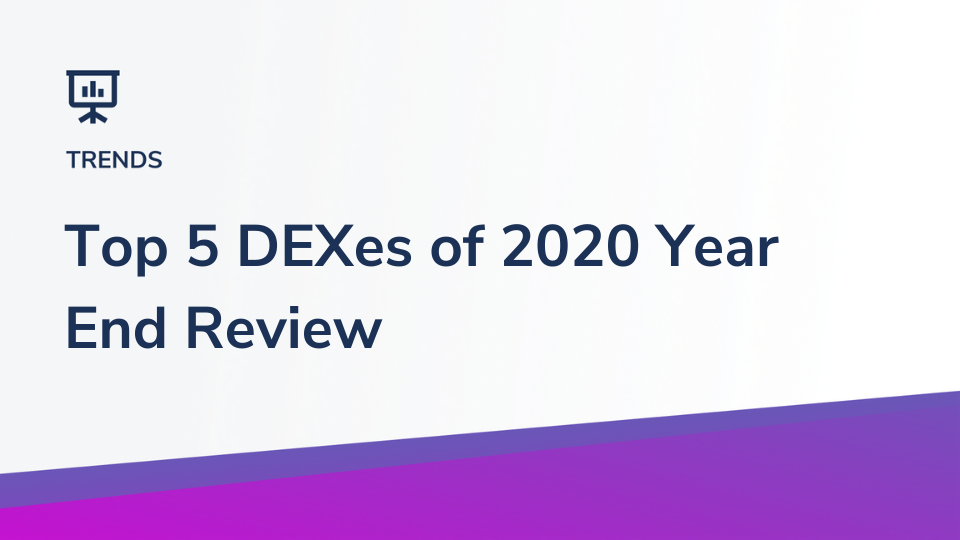Top 5 DEXes of 2020 Year End Review

2020 — Year of the DEXes
2020 has been a break out year for DEXes (Decentralized Exchanges). This became obvious when Uniswap processed $15.3 billion in monthly volume in September — beating the numbers for the most prominent US player in the centralized exchange space, Coinbase. As we look towards 2021, we wanted to look at the projects that maintained a high total value locked metric in 2020.

#1 Uniswap — Total Value Locked ~$1.8 billion
The most popular DEX, Uniswap, has maintained a high TVL even after ending their popular liquidity mining project that was distributing UNI tokens as a reward. Their TVL was as high as $3 billion at one point in 2020.
Uniswap is an automated liquidity protocol powered by a constant product formula and implemented in a system of non-upgradeable smart contracts on the Ethereum blockchain. It obviates the need for trusted intermediaries, prioritizing decentralization, censorship resistance, and security. Uniswap is open-source software licensed under the GPL. Each Uniswap smart contract, or pair, manages a liquidity pool made up of reserves of two ERC-20 tokens.
Anyone can become a liquidity provider for a pool by depositing an equivalent value of each underlying token in return for pool tokens. These tokens track pro-rata LP shares of the total reserves, and can be redeemed for the underlying assets at any time.

#2 Sushiswap — Total Value Locked ~$1.1 billion
Sushiswap is a fork of the Uniswap code that started a liquidity mining program before Uniswap started theirs, which allowed them to take a lot of market share from Uniswap. Sushiswap still has incentivized pools, which create attractive returns for liquidity pool providers.
SushiSwap is an automated market-making (AMM) decentralized exchange (DEX) currently on the Ethereum blockchain that is soon expanding its offerings with the BentoBox lending platform. They are a community-run project governed by the community’s vote for all major changes to the protocol. Day to day operations, rebalancing of pools and ratios, business strategy, and overall development is ultimately decided on by core developer Sushi Chef 0xMaki

3. Curve — Total Value Locked ~$910 million
Curve is the king of stable coin swaps and maintains high volume by doing that task very efficiently. They also have some liquidity pools with attractive returns using their CRV token as a reward. It should be noted that the DeFi Pulse and Curve report different figures for the total amount locked in the protocol.
Its main goal is to let users and other decentralized protocols exchange stablecoins (DAI to USDC, for example) through low fees and low slippage. Unlike exchanges out there that match a buyer and a seller, Curve’s behavior is different; it uses liquidity pools like Uniswap. To achieve this, Curve needs liquidity (tokens), which is rewarded by those who provide it.
Curve is non-custodial, meaning the Curve developers do not have access to your tokens.

4. Balancer — Total Value Locked ~$540 million
Balancer is an innovator in the AMM space, introducing technology that allowed for more types of liquidity pools outside of the 50/50 model Uniswap employs (80/20, 95/5, etc.). They also support single asset deposits. Two categories of users can benefit from the Balancer Protocol: liquidity providers — who own Balancer Pools or participate in shared pools, and traders — who buy or sell the underlying pool assets on the open market.
Anyone can be a liquidity provider. For example:
- Portfolio managers who want to have controlled exposure to different assets without complicated and expensive rebalancing
- Investors who have ERC20 tokens sitting idly in a wallet and would like to put them to work earning passive income from fees
Traders can choose from a diverse set of pools, each presenting a unique set of investment opportunities and challenges through its particular configuration of tokens, weights, and fees. The interplay between these settings, pool volume, and external prices generates market forces that incentivize traders to maintain stable token ratios, thereby preserving asset value for liquidity providers.
There are three main categories:
- “Retail” traders seeking to exchange tokens with low slippage at favorable rates
- Arbitrageurs seeking profit through leveling market inefficiencies between DEXs or CEXs
- Ethereum smart contracts seeking liquidity for various reasons, such as liquidating positions on other protocols, trading on behalf of users, etc.

5. Bancor — Total Value Locked ~$120 million
Bancor is a DEX trying to solve the impermanent loss problem for liquidity providers. They have a model that compensates liquidity providers by issuing them tokens to cover the pool’s loss. The Bancor Protocol is a fully on-chain liquidity protocol that can be implemented on any smart contract-enabled blockchain. The Bancor Protocol is an open-source standard for liquidity pools, which in turn provide an endpoint for automated market-making (buying/selling tokens) against a smart contract. Bancor Network currently operates on the Ethereum and EOS blockchains, but the protocol is designed to be interoperable for additional blockchains.
- Implementation can be easily integrated into any application, enabling value exchanges.
- Implementation is open source and permissionless, and ecosystem participants are encouraged to contribute to and enhance the Bancor Protocol.

2021 and Beyond
Given all the excitement surrounding the DEX space in 2020, we are eagerly looking forward to what the Top 5 DEX list of 2021 will look like! We know there are significant upgrades planned to some protocols, and the space is expanding at a healthy pace. Keep your eye on the DEX space, and there is plenty more room to grow!

Check out APY.Vision!
APY.Vision is an advanced analytics tool for liquidity pool providers and yield farmers. If you’re using any DEXs, AMMs, or liquidity pools this is the tool you will need to easily track the ROI of your liquidity provider and yield farming activities. Try it now!
APY.Vision does not give investment advice and always insists that you do your own research. Read our full Legal Disclaimer.
